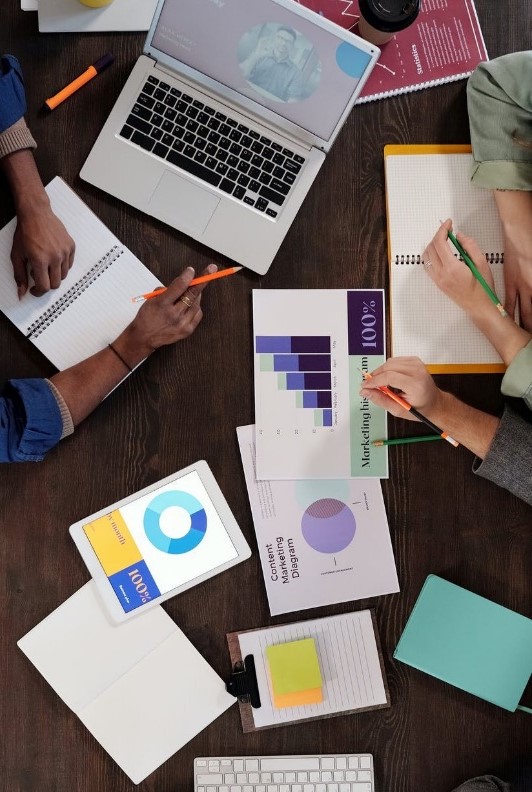 One thing is for certain. The past couple of years have brought about a large amount of forced transformation for many fields of work and many industries. In recent interviews published by The Scholarly Kitchen, Robert Harington, Associate Executive Director of the American Mathematical Society (AMS), dives into these transformations and how they have and will continue to impact scholarly societies. The interviews focus on the perspectives of several Society Executive Directors/CEOs and how they have dealt with the effects of COVID-19 and the increasing adaptation of open access models. (Harrington, 2022a).
One thing is for certain. The past couple of years have brought about a large amount of forced transformation for many fields of work and many industries. In recent interviews published by The Scholarly Kitchen, Robert Harington, Associate Executive Director of the American Mathematical Society (AMS), dives into these transformations and how they have and will continue to impact scholarly societies. The interviews focus on the perspectives of several Society Executive Directors/CEOs and how they have dealt with the effects of COVID-19 and the increasing adaptation of open access models. (Harrington, 2022a).
The Executive Director of the Genetics Society of America, Tracey DePellegrin, describes how this new landscape “gave rise to refining the way we operate in a virtual environment.” In these times, the concept of absolute loyalty to a particular society is not as common as it had been in the years prior. “Members today want to know what we as societies can do for them,” states DePellegrin (Harrington, 2022b). Societies must prove themselves not just through their mission statements but through each action they take and what those actions provide to their members and the future of scholarly research.
 The Executive Director of the American Historical Association (AHA), James Grossman, responded to this challenge by initiating an annual event that is fully online. The approach to this type of virtual environment was very calculated and experimental. Grossman explains that there were positives too that came from this experiment that would not have been possible otherwise. For one, an online platform allows attendance of people who could not have travelled to the in-person event for reasons of time, money, physical restrictions, family constraints, etc. However, there is no way to fully replicate the effect of what would be an in-person event, virtually (Harrington, 2022a).
The Executive Director of the American Historical Association (AHA), James Grossman, responded to this challenge by initiating an annual event that is fully online. The approach to this type of virtual environment was very calculated and experimental. Grossman explains that there were positives too that came from this experiment that would not have been possible otherwise. For one, an online platform allows attendance of people who could not have travelled to the in-person event for reasons of time, money, physical restrictions, family constraints, etc. However, there is no way to fully replicate the effect of what would be an in-person event, virtually (Harrington, 2022a).
“Not only do some things not translate, but there are also opportunities online that are impossible in person,” says Grossman.
Regardless, he is very optimistic about the new possibilities and eager to experiment within this everchanging landscape. Grossman states that AHA “will experiment, beginning modestly and then expanding as we learn” (Harrington, 2022a).
Even in this new state of the world where “there is always a layer of uncertainty,” says Executive Director of INFORMS, Elena Gerstmann, these society leaders find plenty of room for new ideas, opportunities, and solutions (Harrington, 2022a).
Gerstmann states that “The pandemic has allowed us to think about our organization and tear down some useless, self-imposed, silos.” At INFORMS, they took the pandemic as an opportunity to vet their long-standing procedures and how they do or do not serve them in today’s environment. This included the introduction of new campaigns such as personal outreaches to authors who were not currently members and a new online forum for new members to congregate and discuss interests, experiences, questions, etc. (Harrington, 2022a).
 Chief Executive of Institute of Physics Publishing (IOPP), Antonia Seymour, also had a similar approach and took this time to really dive in to their communication tactics and enhance them where they were lacking effectiveness. In order to better understand their community, they took a data-focused approach. One of the more convenient things about the virtual world is the ability to track marketing and analytics. Businesses, communities, and societies alike can track customers’ and potential customers’ behavior to better understand their goals and fears and how these impact their decision making. Seymour took this time to use these tools and understand their community readers, reviewers, and authors as well as they possibly could (Harrington, 2022b).
Chief Executive of Institute of Physics Publishing (IOPP), Antonia Seymour, also had a similar approach and took this time to really dive in to their communication tactics and enhance them where they were lacking effectiveness. In order to better understand their community, they took a data-focused approach. One of the more convenient things about the virtual world is the ability to track marketing and analytics. Businesses, communities, and societies alike can track customers’ and potential customers’ behavior to better understand their goals and fears and how these impact their decision making. Seymour took this time to use these tools and understand their community readers, reviewers, and authors as well as they possibly could (Harrington, 2022b).
Recently we have also seen a large push away from the dated traditional publishing models and toward the implementation of the Open Access (OA) movement. Robert Harington, Executive Director of AMS, speaks on the challenges that AMS faces when working to support OA as a mathematics community, specifically. Harington made it very clear that AMS is fully behind open research and the OA movement. However, many mathematic communities do struggle to maintain open access models since they often do not receive direct funding for their research. This makes options like Gold Open Access often not feasible for them. In order to best address the issues, Harington is working to provide a range of models that are sustainable for all circumstances and communities (Harrington, 2022b).
AMS is determined to re-implement their original publication model where all content is completely free and available online with a five-year moving window. This approach includes all of the following as hybrid options:
-
Green Open Access
Allows the author to publish an earlier version of their manuscript in repositories and online. This option allows the author to share their article without having to pay any Article Processing Charge (Taylor and Francis Online, n.d.). -
Subsidized Gold Open Access, providing waivers for OA members
Gold Open Access means the finalized version of your manuscript is published and freely available. This will usually involve an article processing charge, which is why providing waivers for members would assist those who are not directly funded (Taylor and Francis Online, n.d.). -
Donor Supported Diamond Open Access
Diamond OA is a form of Gold OA that does not include a requirement for authors to pay article processing charges (APCs). This is only possible when there is a large amount of funding coming from either the society, donors, or a combination of both (Harrington, 2017).
There comes significant challenges and complexity when navigating a market with a spectrum of transformative agreements. There is a risk and concern that certain transformative agreements are not as “transparent” or “equitable” as they should be. Harington states that the goals of AMS are to develop new Open Access business models that are sustainable for all ends of the agreement (Harrington, 2022b). This of course is not an easy fix.
IOP Publishing’s response as a community for physics research is what Seymour calls a “progressive, inclusive, and equitable approach” implementing these transformative agreements effectively (Harrington, 2022b). The objective is to build loyalty by providing substantial benefits and opportunities to their customers and partners. Antonia Seymour, Chief Executive of IOPP, aims to ensure that these transformative agreements are successful by first developing a deep understanding and connections within the scientific community. These continuous connections and exchanges of ideas are the basis on which the Open Access models are founded. IOP Publishing has created several new open access journals and in doing so has also strategically pushed their agenda for open access of information by now requiring open data availability statements for all submissions to any of their journals. All of their efforts come from this motive to deepen and broaden connections across
scientific communities.
 Aside from the challenges that have come with the pandemic as well as the implementation of Open Access models across scientific communities, there are positive impacts that are worth mentioning. Elena Gerstmann, Executive Director of INFORMS, mentions that throughout the pandemic there has been a significant increase in their scholarly publications, and they have been able to substantially shorten the amount of time it takes for a manuscript to go from acceptance to publication (Harrington, 2022a). Since INFORMS was already able to publish Open Access for all of their journals, they were, like many other societies, prepared to function in an increasingly Open Access environment. However, they remain vigilant and observant as to how they can consistently improve and are prepared to adapt to any changes that may come their way.
Aside from the challenges that have come with the pandemic as well as the implementation of Open Access models across scientific communities, there are positive impacts that are worth mentioning. Elena Gerstmann, Executive Director of INFORMS, mentions that throughout the pandemic there has been a significant increase in their scholarly publications, and they have been able to substantially shorten the amount of time it takes for a manuscript to go from acceptance to publication (Harrington, 2022a). Since INFORMS was already able to publish Open Access for all of their journals, they were, like many other societies, prepared to function in an increasingly Open Access environment. However, they remain vigilant and observant as to how they can consistently improve and are prepared to adapt to any changes that may come their way.
Many societies are learning to be innovative and flexible in their work. James Grossman, Executive Director of the AHA, is working as an advocate for OA and “advocate for digitization of the primary sources that are essential to the democratization of scholarship and teaching and for free and open access to archives and other repositories.” At the American Historical Association (AHA), Grossman outlines the efforts being made to further the implementation of OA and the 17 UN Sustainable Development Goals. “We currently have a committee working on broadening definitions of scholarship, in order to make it professionally more feasible for historians to write for broad audiences,” says Grossman (Harrington, 2022a).
As many of them mention what they have learned over the past few years and are still learning, the biggest take aways are ways to combat challenges through being flexible and embracing change and innovative ideas. Rather than setting new permanent guidelines, they are preparing themselves for all types of changes and experimenting with how to best serve their communities and navigate new environments.
About eContent Pro: eContent Pro is a U.S.-based professional editorial and publishing services provider for authors, publishing houses, libraries, organizations, university presses, and societies. Offering professional copy editing, translation, scientific and scholarly editing, journal recommendation, typesetting, figure, chart, table, and equation conversions, as well as other production services, we have provided the highest quality editorial services and content advisement to scholarly outlets and individuals around the world. To learn more about eContent Pro, visit the website here or email customerservice@econtentpro.com.
REFERENCES
- Harrington, R. (2017, June 1). Diamond open access, societies and mission. The Scholarly Kitchen. https://scholarlykitchen.sspnet.org/2017/06/01/diamond-open-access-societies-mission/
- Harrington, R. (2022a, Feb. 21). The future of scholarly societies: Interviews with society leaders (Part 1). The Scholarly Kitchen. https://scholarlykitchen.sspnet.org/2022/02/21/the-future-of-scholarly-societies-interviews-with-society-leaders-part-1/
- Harrington, R. (2022b, Feb. 22). The future of scholarly societies: Interviews with society leaders (Part 2). The Scholarly Kitchen. https://scholarlykitchen.sspnet.org/2022/02/22/the-future-of-scholarly-societies-interviews-with-society-leaders-part-2/?informz=1
- Taylor and Francis Online. (n.d.). What are the gold and green open access publishing options? Taylor and Francis Online. https://authorservices.taylorandfrancis.com/publishing-open-access/oa-green-gold/

